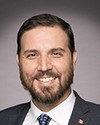Mr. Speaker, it is an honour and privilege to rise again tonight to speak to Bill C-10. It is always an honour to speak from the unceded traditional territory of the Snuneymuxw First Nation, and to serve the community of Nanaimo—Ladysmith within the traditional territory of the Snaw-naw-as, Snuneymuxw, Stz'uminus and Lyackson First Nations. Hych'ka Siem. It is National Aboriginal Peoples Day today, a day to celebrate the rich cultural heritage, the languages, the governance structure and the traditions of the indigenous people of Canada.
I spoke to many organizations about this bill. As an independent party called the Greens, we do not have the same ability to question witnesses in committee, so I held my own meetings and asked my own questions. One of the meetings I had was with APTN and indigenous producers. I want to talk tonight about the importance of indigenous voices in our broadcasting system. If we left this content up to the United States, our views of indigenous people would continue to be the Disneyfied view seen in Pocahontas and spaghetti westerns. It is really important that indigenous voices are heard.
In the early 1990s, my father found a letter written by a woman in 1898 named Elizabeth Shaw. She wrote a scathing 18-page letter about the residential school system and the abuses that were happening at the Port Simpson school. We made a documentary film about her and a number of indigenous people were involved with it.
Afterward, indigenous people told me about some of the other experiences they had and they wanted to make films as well. I said that it was not really for me to tell their story. That is what they should be doing and I helped facilitate it. I worked with a lot of indigenous producers, young people and older people. These people were interested in getting into media production, and I facilitated training and mentorship so they could tell their stories.
What came out of that? I worked with a young guy, Don Claxton. I worked with his sister Dana Claxton as well, who is an indigenous artist, and played music with their sister, Kim Soo Goodtrack. They had an idea for a show. That was in the late 1990s and, lo and behold, APTN, the Aboriginal Peoples Television Network, was born. We produced a pilot for the first preschool show on APTN. I worked with them, a whole bunch of first nations and an indigenous technical crew, who we trained, to create 64 episodes of a show called Wakanheja.
The idea behind CanCon is to hear these important indigenous voices. We need to make sure that the independent producers creating Canadian content have access to the Canada Media Fund when they are producing for social media streamers like Netflix and others, rather than just for the Canadian broadcasters, because that is where a lot of this production is going.
I heard a lot of discussion about freedom of expression and that some YouTubers have to go down because Canadian content goes up, that somebody has to go down because somebody is going up. I do not know how many times I heard that at committee during filibusters. A Conservative member gave a great example of somebody they know who does coupon clipping and gives how-tos, and that is great. I looked at the top 100 Canadian YouTube producers and there were people doing nails, gaming commentators and spoof videos. There was lots of content that could be produced anywhere. People knew it was Canadian because they would drop an “eh”, say “get 'er done” or say “about” wrong, but that is not what the idea behind CanCon is all about.
This commercial content drives advertising dollars, and that is what the commercial Internet giants are all about: selling advertising. That is what the algorithms are designed to do. What is important in CanCon is indigenous voices, stories from Canada's north, Canadian documentaries, stories of new Canadians and emerging Canadian musicians. These are the programs that need to be discoverable, and that is what discoverability is about. It is about learning about each other and about Canadian stories, not being inundated by American culture or the dominant culture.
I missed my late show tonight. I want to talk about a Canadian story that needs to be shared and understood. In recent decades, Canadians have learned more and more about our former government's attempt to commit cultural genocide, to commit genocide, to wipe out indigenous cultures through the residential school system. The Truth and Reconciliation Commission has reported extensively and provided a path forward with 94 calls to action.
What most Canadians are unaware of is a parallel set of institutions, the racially segregated Indian hospital system operated by the federal government between the 1940s and 1970s, and those hospitals have their own horror stories. I first heard about the Nanaimo Indian Hospital about 15 years ago, and many people in my community have no idea it ever existed.
In 2013, I was commissioned to produce a film for the Hul'qumi'num Health Hub about cultural safety in the health care system within the Hul'qumi'num speaking areas. Part of that film was to give health professionals an understanding of the history of institutional racism in health care and why indigenous people did not seek help when they needed medical attention.
I interviewed elders who spoke about the trauma they experienced in the Nanaimo Indian Hospital. I heard about painful treatments and I heard about people going into the hospital who were never heard from again. As part of the research for the film, I spoke with researcher Laurie Meijer Drees, who is the co-chair of the First Nations Studies Department at Vancouver Island University. She has documented the oral stories of people who have been in these hospitals, and wrote a book entitled Healing Histories: Stories from Canada's Indian Hospitals.
Of course, not all these stories were bad. Some people went to the hospital sick, were given antibiotics and returned home feeling better, but the horrific legacy of the Indian hospitals was based on treating all indigenous people as wards of the state. Consent for medical treatment only came into being for the general public in the 1960s. However, as wards of the state, indigenous people were not asked to consent for their hospitalization or treatment. The system patronizingly viewed them as lacking the capacity to give consent.
An indigenous person could be arrested by the RCMP for not going to the hospital if instructed to do so by a doctor. That twisted, racist mentality facilitated and led to women being sterilized without giving consent and patients being subject to experiments with medication without their prior knowledge.
These hospitals were underfunded and understaffed. Family members and communities were not updated on loved ones in the hospital. People died, children were shipped off to residential school or adopted out and family members were never informed. Some children were taken to hospital and years later no longer knew who they were, what their real names were or where they came from.
Most of what is known about this dark history comes from oral accounts told to researchers and shared through the Truth and Reconciliation Commission, but the medical files are locked and researchers have not been granted permission to access them. Apparently the reason given is that those records contain personal information. It is important to protect personal information, however, we do not need to expose personal information to get to the bottom of what happened.
To heal from those past traumas, we need to know the truth. The truth is sealed in those medical records, and it is incumbent upon the government to give researchers and independent adjudicators appropriate clearance, access and analysis of this data to conduct a full independent inquiry. I am looking forward to a first nations producer, an indigenous producer, creating a documentary about this and having members of this place finding this through discoverability on YouTube. These are stories we need to hear. These are the truths we need to hear. We also need to hear about the rich cultural heritage of indigenous people.
Let us talk about censorship. We are worried about censorship. The real concern about censorship is these large corporations. On May 5, red dress day, the National Day of Awareness for Missing and Murdered Indigenous Women and Girls, family, friends and loved ones were posting about their missing loved ones. Thousands of those posts disappeared.
Right here in my community, I know Lisa Marie Young went missing years ago. What happened to all these posts? They were all pulled by Instagram. This is happening with other things like Black Lives Matter, Israel and Palestine, Sheikh Jarrah and SOS Colombia. I heard one of the Conservatives say that their posts were missing, right-wing posts, but this is clearly not Conservative posts.
Freedom of speech is important to me and we need to uphold it, and this bill would do that.









